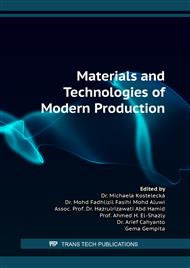[1]
M. Samy, M.G. Ibrahim, M. Fujii, K.E. Diab, M. Elkady, G. Alalm, CNTs / MOF-808 painted plates for extended treatment of pharmaceutical and agrochemical wastewaters in a novel photocatalytic reactor, Chem. Eng. J. 406 (2021) 7. https://doi.org/10.1016/j.cej.2020.127152.
DOI: 10.1016/j.cej.2020.127152
Google Scholar
[2]
M. Samy, M.G. Ibrahim, M.G. Alalm, M. Fujii, Modeling and Optimization of Photocatalytic Degradation of Methylene Blue Using Lanthanum Vanadate, Materials Science Forum 1008 (2020) 97–103. https://doi.org/10.4028/www.scientific.net/MSF.1008.97.
DOI: 10.4028/www.scientific.net/msf.1008.97
Google Scholar
[3]
G. Crini, E. Lichtfouse, Advantages and disadvantages of techniques used for wastewater treatment, Environ. Chem. Lett. 17 (2019) 145–155. https://doi.org/10.1007/s10311-018-0785-9.
DOI: 10.1007/s10311-018-0785-9
Google Scholar
[4]
M. Samy, M. Mossad, H.K. El-Etriby, Synthesized nano titanium for methylene blue removal under various operational conditions, Desalin. Water Treat. 165 (2019) 374–381. https://doi.org/10.5004/dwt.2019.24510.
DOI: 10.5004/dwt.2019.24510
Google Scholar
[5]
M. Samy, M.G. Ibrahim, M.G. Alalm, M. Fujii, K.E. Diab, M. Elkady, Innovative photocatalytic reactor for the degradation of chlorpyrifos using a coated composite of ZrV2O 7 and graphene nano-platelets, Chem. Eng. J. (2020) 124974. https://doi.org/10.1016/j.cej.2020.124974.
DOI: 10.1016/j.cej.2020.124974
Google Scholar
[6]
K. Mensah, H. Mahmoud, M. Fujii, H. Shokry, Novel nano-ferromagnetic activated graphene adsorbent extracted from waste for dye decolonization, J. Water Process Eng. 45 (2022) 102512. https://doi.org/10.1016/j.jwpe.2021.102512.
DOI: 10.1016/j.jwpe.2021.102512
Google Scholar
[7]
M. Samy, M.G. Ibrahim, M. Gar Alalm, M. Fujii, Effective photocatalytic degradation of sulfamethazine by CNTs/LaVO4 in suspension and dip coating modes, Sep. Purif. Technol. 235 (2020) 116138. https://doi.org/10.1016/j.seppur.2019.116138.
DOI: 10.1016/j.seppur.2019.116138
Google Scholar
[8]
M. Samy, M.G. Ibrahim, M. Gar Alalm, M. Fujii, S. Ookawara, T. Ohno, Photocatalytic degradation of trimethoprim using S-TiO2 and Ru/WO3/ZrO2 immobilized on reusable fixed plates, J. Water Process Eng. 33 (2020) 3–10. https://doi.org/10.1016/j.jwpe.2019.101023.
DOI: 10.1016/j.jwpe.2019.101023
Google Scholar
[9]
A. Tolba, M. Gar Alalm, M. Elsamadony, A. Mostafa, H. Afify, D.D. Dionysiou, Modeling and optimization of heterogeneous Fenton-like and photo-Fenton processes using reusable Fe3O4-MWCNTs, Process Saf. Environ. Prot. 128 (2019) 273–283. https://doi.org/10.1016/j.psep.2019.06.011.
DOI: 10.1016/j.psep.2019.06.011
Google Scholar
[10]
A. Adel, M.G. Alalm, H.K. El-Etriby, D.C. Boffito, Optimization and mechanism insights into the sulfamethazine degradation by bimetallic ZVI/Cu nanoparticles coupled with H2O2, J. Environ. Chem. Eng. 8 (2020). https://doi.org/10.1016/j.jece.2020.104341.
DOI: 10.1016/j.jece.2020.104341
Google Scholar
[11]
M. Samy, M.G. Alalm, M. Mossad, Utilization of iron sludge resulted from electro-coagulation in heterogeneous photo-fenton process, Water Pract. Technol. 15 (2020) 1228–1237. https://doi.org/10.2166/wpt.2020.093.
DOI: 10.2166/wpt.2020.093
Google Scholar
[12]
R. Saleh, A. Taufik, Degradation of methylene blue and congo-red dyes using Fenton, photo-Fenton, sono-Fenton, and sonophoto-Fenton methods in the presence of iron(II,III) oxide/zinc oxide/graphene (Fe3O4/ZnO/graphene) composites, Sep. Purif. Technol. 210 (2019) 563–573. https://doi.org/10.1016/j.seppur.2018.08.030.
DOI: 10.1016/j.seppur.2018.08.030
Google Scholar
[13]
P. Goyal, S. Chakraborty, S.K. Misra, Multifunctional Fe3O4-ZnO nanocomposites for environmental remediation applications, Environ. Nanotechnology, Monit. Manag. 10 (2018) 28–35. https://doi.org/10.1016/j.enmm.2018.03.003.
DOI: 10.1016/j.enmm.2018.03.003
Google Scholar
[14]
M.S. Nas, E. Kuyuldar, B. Demirkan, M.H. Calimli, O. Demirbaş, F. Sen, Magnetic nanocomposites decorated on multiwalled carbon nanotube for removal of Maxilon Blue 5G using the sono-Fenton method, Sci. Rep. 9 (2019) 1–11. https://doi.org/10.1038/s41598-019-47393-0.
DOI: 10.1038/s41598-019-47393-0
Google Scholar
[15]
W. Da Oh, Z. Dong, T.T. Lim, Generation of sulfate radical through heterogeneous catalysis for organic contaminants removal: Current development, challenges and prospects, Appl. Catal. B Environ. 194 (2016) 169–201. https://doi.org/10.1016/j.apcatb.2016.04.003.
DOI: 10.1016/j.apcatb.2016.04.003
Google Scholar
[16]
A. Wang, Z. Chen, Z. Zheng, H. Xu, H. Wang, K. Hu, K. Yan, Remarkably enhanced sulfate radical-based photo-Fenton-like degradation of levofloxacin using the reduced mesoporous MnO@MnOx microspheres, Chem. Eng. J. 379 (2020) 122340. https://doi.org/10.1016/j.cej.2019.122340.
DOI: 10.1016/j.cej.2019.122340
Google Scholar
[17]
T. Soltani, B.K. Lee, Enhanced formation of sulfate radicals by metal-doped BiFeO3 under visible light for improving photo-Fenton catalytic degradation of 2-chlorophenol, Chem. Eng. J. 313 (2017) 1258–1268. https://doi.org/10.1016/j.cej.2016.11.016.
DOI: 10.1016/j.cej.2016.11.016
Google Scholar
[18]
M. Gar Alalm, M. Samy, S. Ookawara, T. Ohno, Immobilization of S-TiO2 on reusable aluminum plates by polysiloxane for photocatalytic degradation of 2,4-dichlorophenol in water, J. Water Process Eng. 26 (2018) 329–335. https://doi.org/10.1016/j.jwpe.2018.11.001.
DOI: 10.1016/j.jwpe.2018.11.001
Google Scholar
[19]
S. Su, Y. Liu, W. He, X. Tang, W. Jin, Y. Zhao, A novel graphene oxide-carbon nanotubes anchored α-FeOOH hybrid activated persulfate system for enhanced degradation of Orange II, J. Environ. Sci. (China). 83 (2019) 73–84. https://doi.org/10.1016/j.jes.2019.02.015.
DOI: 10.1016/j.jes.2019.02.015
Google Scholar
[20]
J. Yan, M. Lei, L. Zhu, M.N. Anjum, J. Zou, H. Tang, Degradation of sulfamonomethoxine with Fe3O4 magnetic nanoparticles as heterogeneous activator of persulfate, J. Hazard. Mater. 186 (2011) 1398–1404. https://doi.org/10.1016/j.jhazmat.2010.12.017.
DOI: 10.1016/j.jhazmat.2010.12.017
Google Scholar


